nikon coolpix camera instruction manual
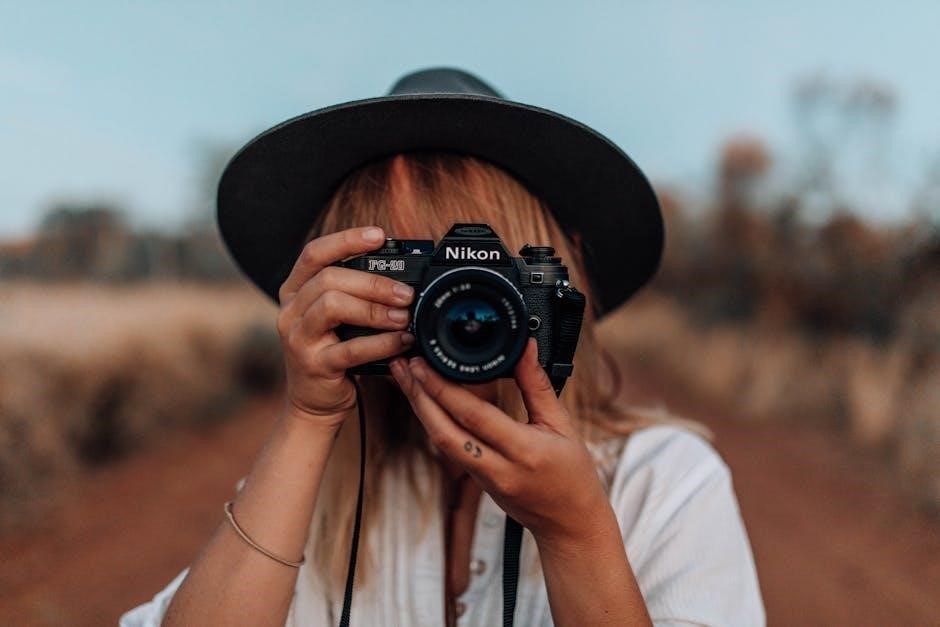
Welcome to the Nikon Coolpix camera instruction manual. This guide provides detailed instructions for setting up‚ operating‚ and troubleshooting your camera. Explore features‚ shooting modes‚ and connectivity options to enhance your photography experience.
1.1 Key Features of the Nikon Coolpix Camera
The Nikon Coolpix camera is designed for enthusiasts‚ offering advanced features like full manual controls‚ superior NIKKOR optics‚ and scene modes for specific shooting scenarios. It supports high-quality image settings‚ wireless connectivity via SnapBridge‚ and 4K video recording. The camera also includes tools for adjusting white balance‚ ISO sensitivity‚ and autofocus modes‚ making it versatile for various photography needs. These features help transition users from basic point-and-shoot functionality to more sophisticated photographic control‚ enhancing creativity and precision in every shot.
1.2 Importance of Reading the Manual
Reading the Nikon Coolpix camera manual is essential for mastering its features and optimizing performance. It provides detailed guidance on operation‚ troubleshooting‚ and customization‚ ensuring users understand advanced settings and modes. The manual helps photographers unlock the camera’s full potential‚ avoid common mistakes‚ and achieve professional results. Familiarizing yourself with the manual enables better control and enhances your overall photography experience‚ making it a valuable resource for both beginners and experienced users.
1.3 Overview of the Manual Structure
This manual is organized into logical sections‚ starting with an introduction to the camera’s key features and safety guidelines. Subsequent chapters cover setup‚ basic and advanced photography operations‚ image optimization‚ connectivity‚ troubleshooting‚ and maintenance. Each section is designed to guide users through understanding and utilizing the camera’s full potential‚ ensuring a smooth learning curve. The manual concludes with additional resources for further support and exploration.
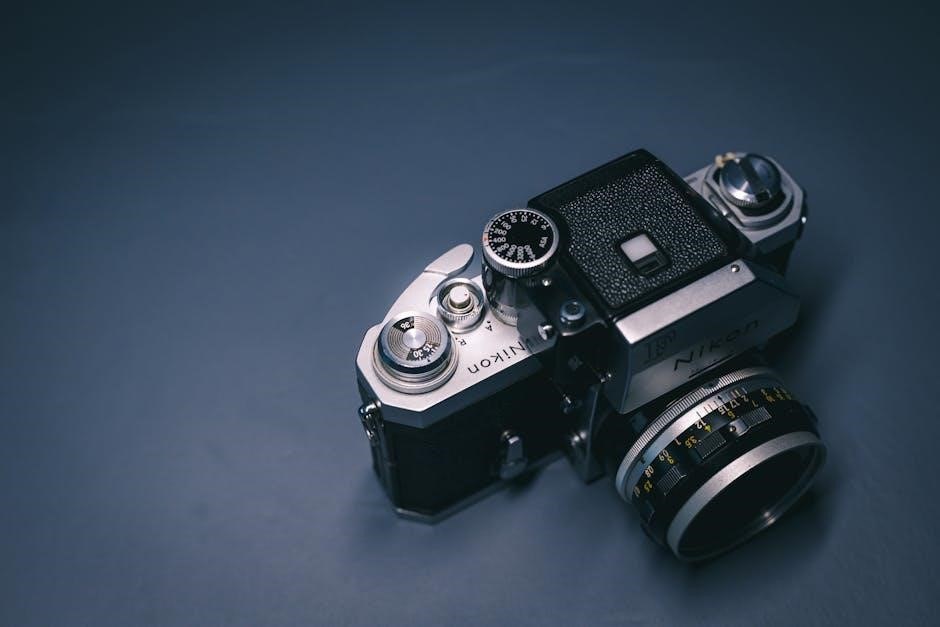
Safety Precautions and Handling the Camera
Always handle the camera with care‚ avoiding water‚ extreme temperatures‚ and physical stress. Clean the lens regularly and store the camera in a protective case when not in use.
2.1 General Safety Guidelines
Handle the camera with care to avoid damage. Keep it away from water‚ moisture‚ and extreme temperatures. Use only Nikon-approved accessories to prevent malfunctions. Clean the lens and camera body regularly with a soft cloth. Avoid touching the lens surface to prevent smudges. Store the camera in a dry‚ cool place when not in use. Be cautious when using the camera near flammable gases or in hazardous environments. Always follow proper charging and battery maintenance procedures.
2.2 Understanding the Camera’s External Controls
Familiarize yourself with the camera’s external controls for optimal use. The Mode Dial allows you to switch between shooting modes like Auto‚ P‚ S‚ A‚ and M. The Shutter Button captures images‚ while the Zoom Ring adjusts the lens focal length. The LCD screen displays settings and previews shots. Use the Menu Button to access camera settings and the Playback Button to review images. The Delete Button helps manage stored photos. Experiment with these controls to enhance your photography experience.
2.3 Proper Storage and Maintenance Tips
Store your Nikon Coolpix camera in a cool‚ dry place to prevent moisture damage. Use a silica gel packet to absorb humidity. Avoid extreme temperatures‚ as they can harm the battery and internal components. Clean the lens regularly with a soft cloth to maintain image clarity. Remove the battery when storing for extended periods to prevent leakage. Keep the camera in a protective case to avoid scratches. Proper care ensures longevity and optimal performance.
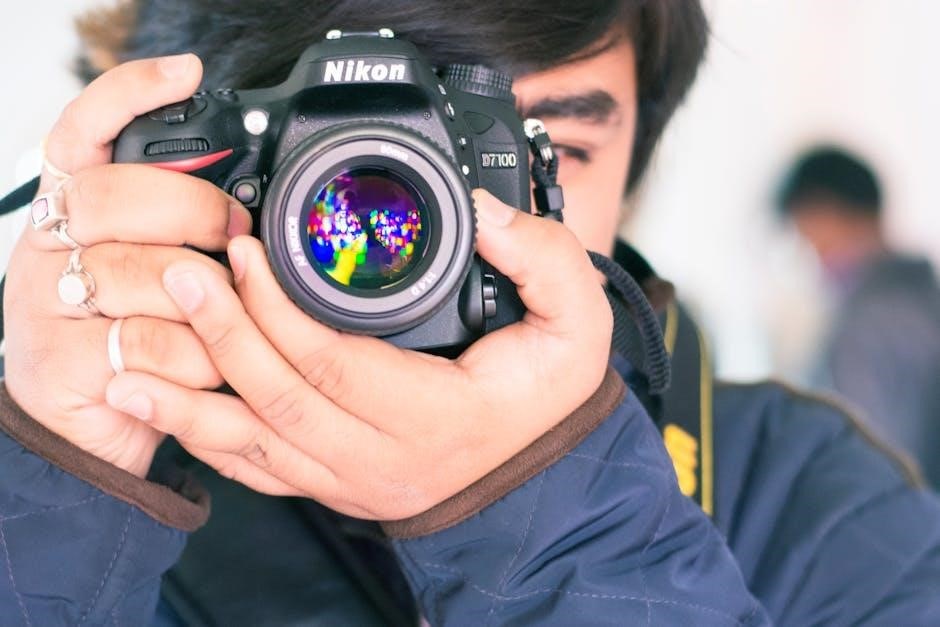
Setting Up Your Nikon Coolpix Camera
Configure your Nikon Coolpix camera with ease by following initial setup steps‚ charging the battery‚ and inserting a memory card to ensure smooth operation and functionality.
3.1 Initial Setup and Configuration
Begin by turning on your Nikon Coolpix camera and completing the initial setup process. Select your preferred language‚ set the date and time‚ and choose your regional settings. Navigate through the menu to customize display options‚ such as monitor brightness and tilt adjustments. Set up default shooting settings‚ including image size‚ quality‚ and autofocus modes. Ensure the viewfinder is adjusted for clarity. Refer to the manual for detailed guidance on these initial configurations to optimize your camera experience.
3.2 Charging the Battery and Power Management
Charge the Nikon Coolpix battery using the provided USB cable and charger. Ensure the battery is fully charged before first use. Avoid overcharging‚ as it may reduce battery lifespan. The camera displays a low battery warning when power is low. Utilize power-saving features like auto-shutoff to conserve energy; Keep spare batteries charged and store them properly. Regularly check battery health and replace it if performance declines. Proper power management ensures uninterrupted photography sessions.
3.3 Inserting and Formatting Memory Cards
Insert the memory card into the Nikon Coolpix camera’s card slot‚ ensuring it clicks securely into place. Use a compatible card type and capacity for optimal performance. Before first use‚ format the card in the camera to ensure proper functionality. Formatting deletes all data‚ so backup important files beforehand. Always eject the card safely to prevent data corruption. Regular formatting helps maintain card performance and compatibility with the camera.
3.4 Updating Firmware and Software
Regularly check for firmware and software updates to ensure optimal camera performance. Visit Nikon’s official website or use the SnapBridge app to download the latest versions. Before updating‚ charge the battery fully and ensure the memory card is formatted. Follow the on-screen instructions carefully to avoid interruptions. Updating enhances camera functionality‚ adds new features‚ and fixes bugs. Always complete the update process as instructed to maintain camera stability and performance.
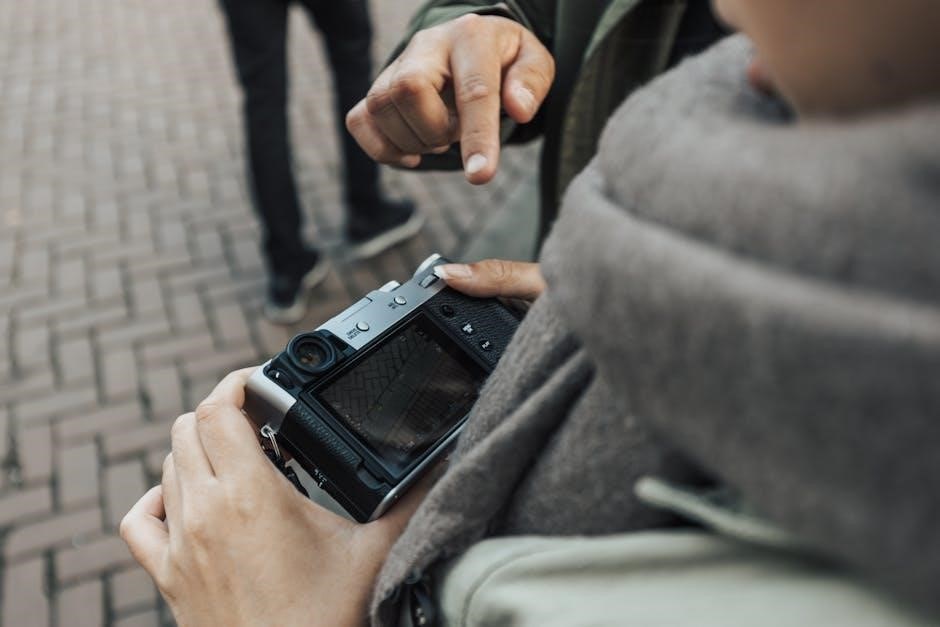
Basic Photography Operations
Master the fundamentals of photography with the Nikon Coolpix‚ exploring essential camera functions‚ shooting modes‚ and image settings to capture stunning photos effortlessly every time.
4.1 Getting Started with Shooting Modes
Familiarize yourself with the Nikon Coolpix’s shooting modes‚ such as Auto‚ Program‚ Shutter Priority‚ Aperture Priority‚ and Manual. Auto Mode is ideal for beginners‚ automatically adjusting settings for optimal results. Program Mode offers flexibility while maintaining ease of use. Shutter and Aperture Priority modes allow control over specific elements‚ while Manual Mode enables full creative freedom. Experiment with these modes to explore different photography styles and enhance your creative expression.
4.2 Adjusting Image Quality and Size Settings
Adjust image quality and size settings to suit your needs. The Nikon Coolpix allows you to choose from various resolutions‚ such as 4K‚ Full HD‚ or lower‚ ensuring optimal file size and detail. Select higher quality for crisp images or reduce size for storage efficiency. Compression levels (Fine‚ Normal‚ Basic) also impact file size and clarity. Experiment with these settings to balance quality and storage requirements based on your shooting needs and preferences.
4.3 Using the Flash and Exposure Compensation
The Nikon Coolpix camera features a built-in flash to illuminate subjects in low-light conditions. You can choose between Auto‚ Forced Flash (fill flash)‚ and Flash Off modes. Exposure compensation allows you to adjust brightness by +/-2 EV in 1/3-stop increments. Use the Flash Mode button and Exposure Compensation dial to enhance your shots. These tools help balance lighting‚ ensuring well-lit‚ natural-looking images even in challenging environments.
4.4 Understanding Focus Modes and Options
The Nikon Coolpix camera offers various focus modes to suit different shooting scenarios. Single AF locks focus on a stationary subject‚ while Continuous AF tracks moving subjects. Face-Priority AF detects and focuses on faces‚ ideal for portraits. Manual Focus allows precise control using the lens ring. Use the Focus Mode button or menu to switch modes. Experiment with these options to capture sharp images in any situation‚ ensuring your subject stands out clearly.
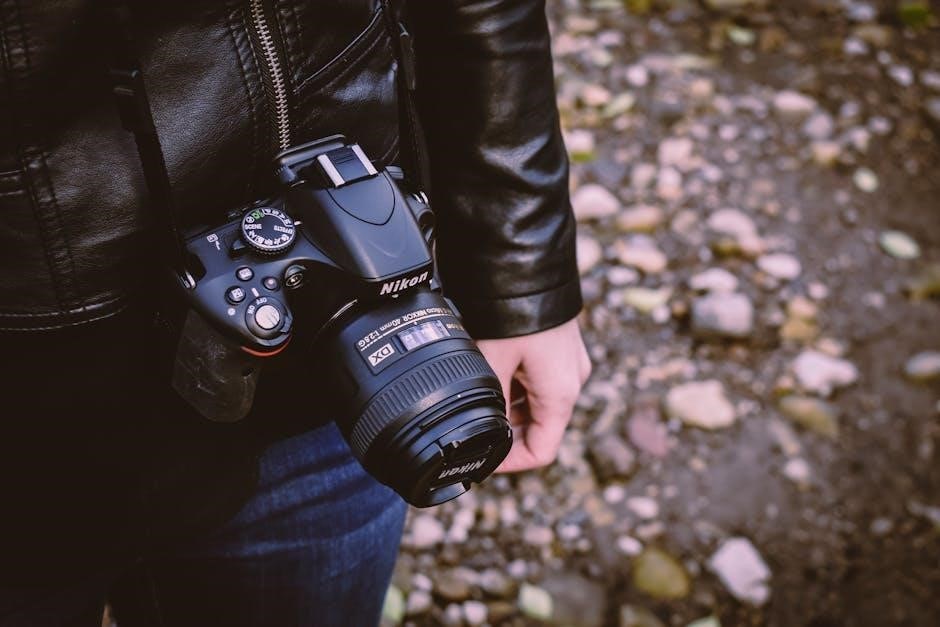
Advanced Features and Customization
This section explores advanced customization options‚ including custom shooting modes‚ scene settings‚ and autofocus adjustments‚ allowing users to tailor the camera to their creative needs.
5.1 Customizing Camera Settings for Personal Preferences
The Nikon Coolpix allows you to tailor settings to your preferences‚ such as custom shooting modes‚ button assignments‚ and personalized menu options. Users can assign frequently used functions to specific buttons‚ like the Fn button‚ for quick access. Additionally‚ the My Menu feature lets you create a custom menu with your most-used settings‚ streamlining your workflow. These options enhance creativity and efficiency‚ ensuring a personalized shooting experience.
5.2 Using Scene Modes for Specific Shooting Scenarios
The Nikon Coolpix offers a variety of Scene Modes tailored for different shooting situations‚ such as Portrait‚ Landscape‚ Night Portrait‚ and Sports. These modes automatically adjust settings like aperture‚ shutter speed‚ and ISO to capture optimal results. For instance‚ the Beach mode enhances colors for seaside shots‚ while the Snow mode ensures vibrant whites. Selecting the appropriate Scene Mode helps you achieve professional-looking photos without manual adjustments‚ making it ideal for beginners and quick captures.
5.3 Advanced Autofocus and Metering Options
Explore advanced autofocus modes like Single AF‚ Continuous AF‚ and Face-Priority AF for precise subject tracking. Customize metering options‚ including Matrix‚ Center-Weighted‚ and Spot Metering‚ to optimize exposure. Utilize AF Lock to maintain focus on moving subjects and AE Lock to fix exposure settings. These features enable greater control over your photography‚ ensuring sharp focus and balanced lighting in challenging scenarios. Experiment with these settings to enhance your creative vision and capture professional-grade images effortlessly.
5.4 White Balance and ISO Sensitivity Adjustments
Adjust the White Balance to match your lighting conditions‚ ensuring accurate colors. Choose from presets like Auto‚ Daylight‚ Tungsten‚ Fluorescent‚ Cloudy‚ and Shade‚ or set a custom value.
Manage ISO Sensitivity to balance image brightness and noise. Lower ISOs (e.g.‚ ISO 100) reduce noise but may require more light‚ while higher ISOs (e.g.‚ ISO 6400) capture images in low light but introduce grain.
For optimal results‚ use the lowest ISO necessary and adjust White Balance to match your scene for natural-looking photos.
Image and Video Quality Optimization
Optimize your Nikon Coolpix camera’s image and video quality by adjusting settings like resolution‚ compression‚ and frame rates. Use manual modes for precise control and better results.
6.1 Enhancing Image Quality with Built-in Filters
Enhance your images using the Nikon Coolpix’s built-in filters to add creative effects. Access filters through the menu‚ selecting options like Neutral Density‚ Color‚ and Special Effects. Apply filters to reduce glare‚ enhance colors‚ or create artistic styles. Experiment with different settings to achieve desired effects‚ ensuring optimal image quality while maintaining the original detail. These filters allow you to refine your photography without post-processing‚ making them a versatile tool for capturing stunning shots effortlessly.
6.2 Recording High-Quality Video and Time-Lapse
Record stunning videos with the Nikon Coolpix by selecting video mode and adjusting settings like resolution and frame rate. Capture sharp‚ detailed footage in 4K UHD for professional-grade results. For time-lapse photography‚ set interval shooting to condense extended periods into a short‚ dynamic sequence. Use a tripod for stability and ensure proper lighting for optimal quality. These features allow you to create compelling visual stories with ease and precision‚ enhancing your creative expression.
6.3 Reducing Noise and Grain in Low-Light Conditions
To minimize noise and grain in low-light photos‚ use the Nikon Coolpix’s noise reduction feature. Lower the ISO sensitivity to reduce digital noise. Enable image stabilization to prevent blur. Shoot in RAW format for better post-processing control. Use the built-in flash or external lighting to brighten scenes; Experiment with slower shutter speeds‚ but stabilize the camera to avoid motion blur. These techniques help capture clearer‚ more detailed images in challenging lighting conditions.
6.4 Using the Built-in Editor for Basic Adjustments
The Nikon Coolpix’s built-in editor allows for quick enhancements. Adjust brightness‚ contrast‚ and saturation to refine images. Use the exposure compensation tool to balance lighting. Apply color balance for warmer or cooler tones. Sharpen images to enhance clarity; Rotate‚ resize‚ or crop photos to improve composition. Save edited files as new copies to preserve originals. These tools enable effortless post-processing without external software‚ making it ideal for on-the-go adjustments.
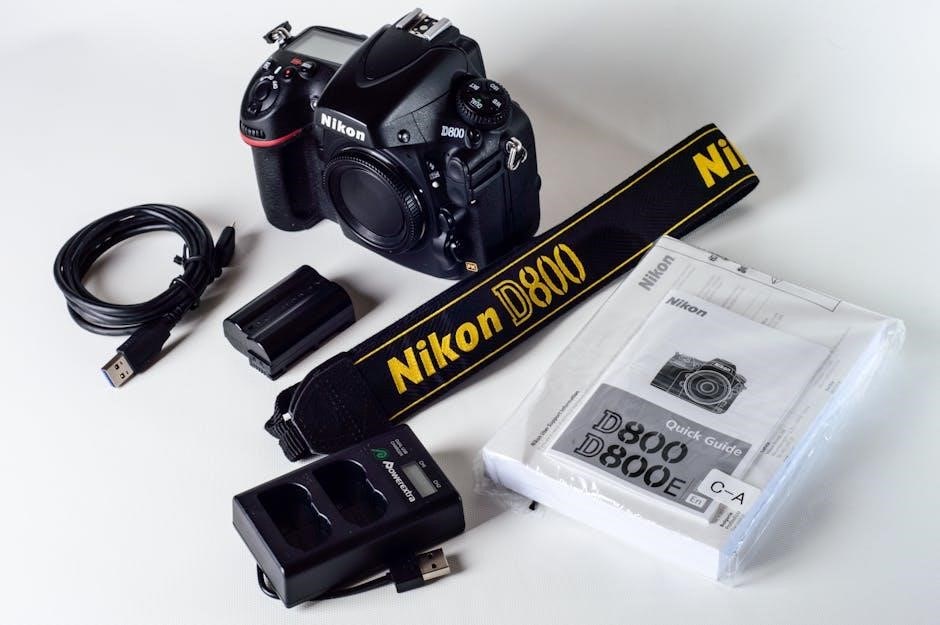
Connectivity and Sharing Options
Explore wireless transfer options‚ mobile app compatibility‚ and remote shooting capabilities. Discover how to share photos instantly and enhance your workflow with seamless connectivity features.
7.1 Transferring Images to a Computer or Mobile Device
Transfer your photos effortlessly using a USB cable‚ Wi-Fi‚ or memory card reader. Connect the camera to your computer or mobile device via cable for quick transfers. For wireless options‚ enable Wi-Fi on the camera and use Nikon’s SnapBridge app to send images directly to your smartphone or tablet. Ensure the device and camera are connected to the same network for seamless transfer. This method allows for efficient backup and sharing of your captured moments.
7.2 Wireless Connectivity and Bluetooth Pairing
Enable wireless connectivity on your Nikon Coolpix camera to transfer images or control the camera remotely. Pair the camera with your smartphone or tablet using Bluetooth via the SnapBridge app. This low-power connection allows seamless image transfer and remote shooting. Ensure both devices have Bluetooth enabled and follow in-app pairing instructions. Once connected‚ you can automatically transfer photos or use your device as a remote shutter release for enhanced convenience.
7.3 Sharing Photos via SnapBridge and Other Apps
Share your photos effortlessly using Nikon’s SnapBridge app‚ which connects your Coolpix camera to smart devices. Transfer images wirelessly and upload them directly to social media‚ cloud storage‚ or photo-sharing platforms. Additionally‚ explore third-party apps for enhanced sharing capabilities. Use built-in Wi-Fi or Bluetooth to send photos to your smartphone‚ then share them instantly. This feature ensures your memories are easily accessible and ready to be shared with friends and family.
7.4 Remote Shooting and Camera Control
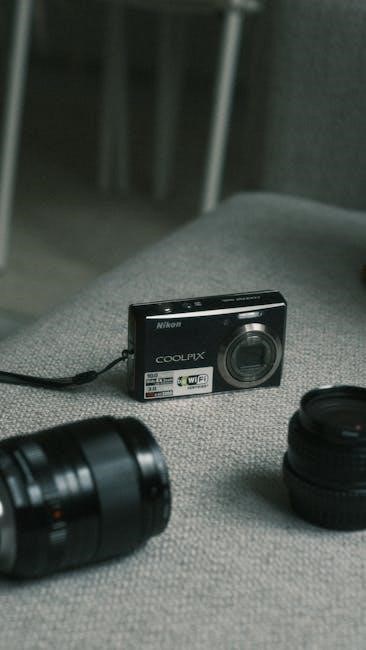
Experience the convenience of remote shooting with your Nikon Coolpix camera. Using the SnapBridge app‚ you can control the camera from your smartphone or tablet. Adjust settings like focus‚ zoom‚ and exposure remotely. Capture photos without physically touching the camera‚ reducing shake and noise. This feature is ideal for group shots‚ wildlife photography‚ or unique perspectives. Ensure the camera and device are connected via Wi-Fi or Bluetooth for seamless control and instant image review.
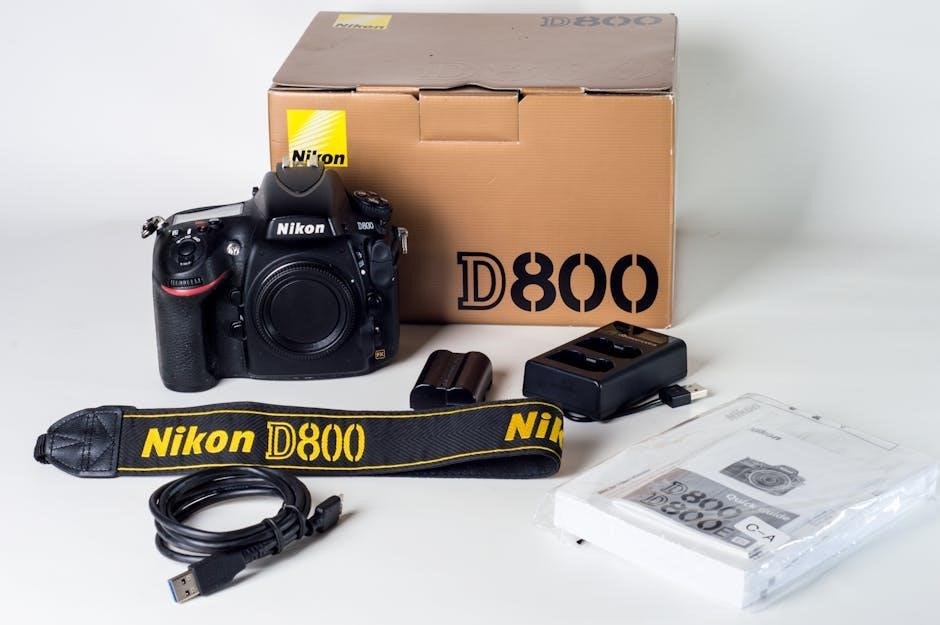
Troubleshooting Common Issues
Troubleshoot common issues like camera malfunctions‚ connectivity problems‚ or image playback errors. Refer to the manual for step-by-step solutions‚ error message interpretations‚ and maintenance tips.
8.1 Resolving Camera Malfunctions and Error Messages
Address camera malfunctions by restarting or resetting to factory settings. Check error messages in the manual for specific solutions. Ensure the battery is charged and connections are secure. Clean the lens and sensor to resolve blurry images or autofocus issues. If problems persist‚ update firmware or contact Nikon support for professional assistance. Always refer to the troubleshooting guide for detailed step-by-step instructions.
8.2 Fixing Connectivity and Transfer Problems
For connectivity issues‚ restart the camera and ensure Bluetooth or Wi-Fi is enabled. Reset network settings if connections fail. Check for firmware updates to resolve compatibility problems. Use original cables for data transfers and ensure they are securely connected. If issues persist‚ restart the camera and connected device. Consult the manual for error codes or contact Nikon support for further assistance. Always verify device compatibility before transferring files.
8.3 Addressing Battery and Power-Related Issues
If the camera fails to turn on‚ ensure the battery is fully charged using the provided charger. Check for debris in the battery compartment and clean it gently. Avoid overcharging‚ as it may reduce battery life. If issues persist‚ reset the camera to its default settings. Update the firmware to the latest version‚ as outdated software can cause power mismanagement. For persistent problems‚ contact Nikon support or visit an authorized service center for professional assistance.
8.4 Solving Image and Video Playback Problems
If images or videos fail to display‚ ensure the memory card is properly inserted and not corrupted. Check the file format compatibility with the camera. Use the camera’s built-in playback menu to refresh or rebuild the file list. If issues persist‚ format the memory card in the camera or transfer files to a computer for verification. Ensure the camera’s firmware is updated‚ as outdated versions may cause playback glitches. For unresolved issues‚ consult the Nikon support website or contact customer service for further assistance.
Maintenance and Upkeep
Regularly clean the lens and camera body with a soft cloth. Store the camera in a dry‚ cool place to prevent moisture damage. Perform firmware updates.
9.1 Cleaning the Camera and Lens
Use a soft‚ dry microfiber cloth to gently wipe the camera body and lens. Avoid harsh chemicals or abrasive materials. For stubborn smudges‚ lightly dampen the cloth with distilled water. Inspect the lens for dust or fingerprints regularly. Use a blower to remove loose debris before wiping. For the lens‚ use a specialized cleaning tissue and circular motions. Never touch the lens surface with bare hands. Clean the camera regularly to maintain image quality and prevent damage. Store cleaning supplies in a dry place.
9.2 Regular Firmware and Software Updates
Regularly update your Nikon Coolpix camera’s firmware and software to ensure optimal performance. Visit Nikon’s official website to check for the latest versions. Use a memory card or connect the camera to a computer for updates. Follow on-screen instructions carefully to avoid interruptions. Updates may enhance features‚ improve autofocus‚ or fix bugs. Always back up settings before updating. Keep your camera up-to-date for the best functionality and new features.
9.3 Storing the Camera Properly When Not in Use
To maintain your Nikon Coolpix camera’s condition‚ store it in a protective case or bag. Use silica gel packets to absorb moisture and prevent mold. Avoid extreme temperatures and humidity. Remove the battery if storing for long periods to prevent leakage. Clean the camera and lens before storage to avoid dirt buildup. Store in a dry‚ cool place to preserve functionality and longevity. Proper storage ensures your camera remains in excellent condition for future use.
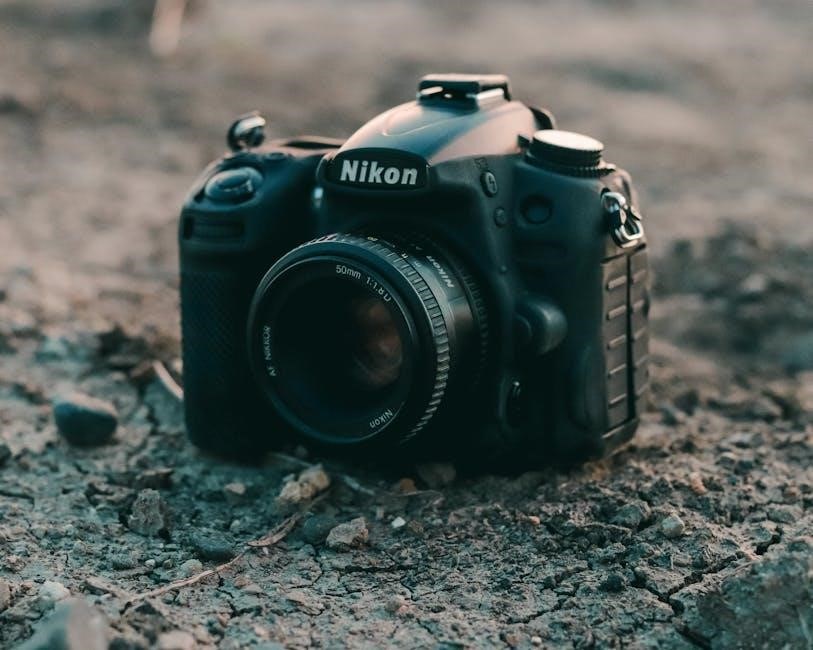
Master your Nikon Coolpix camera by exploring its features and staying updated. Continuous improvement and practice will enhance your photography skills‚ ensuring creativity and precision in every shot.
10.1 Maximizing Your Nikon Coolpix Camera Experience
To maximize your Nikon Coolpix camera experience‚ explore its advanced features and practice regularly. Familiarize yourself with auto and manual modes‚ scene settings‚ and custom options to capture stunning images. Experiment with lighting‚ composition‚ and focus techniques to enhance creativity. Review your photos to identify improvements and refine your skills. Utilize the built-in flash for low-light scenarios and organize your memory cards for efficient storage. Stay updated with Nikon resources and join photography communities for inspiration and support.
10.2 Exploring Advanced Photography Techniques
To explore advanced photography techniques with your Nikon Coolpix‚ experiment with manual modes and creative settings. Try long exposure for dynamic effects‚ panning for motion capture‚ and macro for detailed close-ups. Pay attention to lighting and composition‚ using the camera’s advanced autofocus and metering options. Regularly review your shots to refine your approach and push your creative boundaries. Practice consistently to master these techniques and elevate your photography skills.
10.3 Staying Updated with New Features and Updates
Regularly check for firmware and software updates to ensure your Nikon Coolpix camera performs optimally. Updates often add new features‚ improve functionality‚ and enhance compatibility with accessories. Use the camera’s built-in update menu or Nikon’s official software to download and install the latest versions. Staying updated ensures you access the latest advancements and maintain peak performance. Visit Nikon’s official website or support page for detailed instructions and release notes.
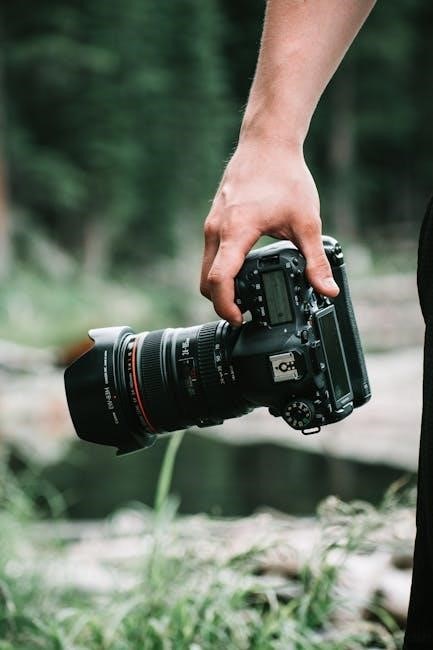
Additional Resources and Support
Explore Nikon’s official website for comprehensive support resources‚ including online manuals‚ troubleshooting guides‚ and FAQs. Visit community forums for peer advice and sharing experiences.
11.1 Accessing Online Manuals and Guides
Visit Nikon’s official website to access the Coolpix camera manual and guides. Download PDF versions or browse interactive tutorials for detailed instructions. Use the search function to find model-specific resources‚ ensuring you have the most up-to-date information. Explore sections dedicated to troubleshooting‚ advanced features‚ and maintenance tips to enhance your photography experience. These resources are designed to help you maximize your camera’s potential effectively.
11.2 Nikon Customer Support and Service Centers
For assistance with your Nikon Coolpix camera‚ visit Nikon’s official website to find contact details for customer support. Locate authorized service centers near you for professional repairs and maintenance. Reach out via phone‚ email‚ or live chat for troubleshooting and guidance. Ensure your camera is serviced by certified technicians to maintain its performance and warranty. Always verify the authenticity of service centers to avoid unauthorized repairs.
11.3 Joining Nikon User Communities and Forums
Engage with fellow Nikon Coolpix users by joining online forums and communities. Share experiences‚ ask questions‚ and learn tips from experienced photographers. Participate in discussions on Nikon’s official forums or platforms like Facebook groups and Reddit. These communities offer valuable insights‚ troubleshooting advice‚ and inspiration for improving your photography skills. Stay updated on the latest trends‚ accessories‚ and techniques. Connecting with others can enhance your overall camera experience and help you make the most of your Nikon Coolpix.